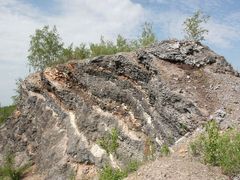Kladno - Botanist Jiří Sádlo is taking a walk at a dump of the former coal-mine Mayrau near Kladno, his eyes carefully scanning the ground.
After a while he bends down to finger a delicate and almost imperceptible wind grass which would hardly be noticed by a regular passer-by.
"Oh my, what a beauty," he enthuses when the magnifying glass reveals what naked eye cannot see.
Loose silky-bent (Apera spica-venti), which the botanist is holding in his hand, does not grow anywhere else in the country.
You can find it only here, on a waste ground of a defunct underground mine, a place so affected by its black coal mining past it could almost seem there is no space for a normal life any more, much less for a critically endangered plant.
The rare grass used to be endemic in the Southern Moravia. Then it disappeared and for tens of years it was considered extinct until the scientists found it on a dump near "Mayrovka".
Wasteland? Think again
However, it is not that uncommon after all. There are other environmentally valuable heaps in the vicinity of Kladno.
"Due to its natural and almost undisturbed development, the heaps near Kladno in many instances became unique habitats, the new nature," says Tomáš Gremlica from the Institute of the Environmental Policy who recently conducted a large scientific research here.
In the 24 heaps which were subjected to the research, botanists found no less than 30 different species of vascular plants, all found in the Red list of endangered species, some of them on the verge of extinction.
Butterflies are represented by at least 140 species, two of which are extremely rare and protected and four others figure in the Red list too.
Institute of the Environmental Policy therefore put forward a suggestion to scrap the plans for wholesale areal recultivation, which would have the heaps razed to the ground and covered with fresh soil.
These heaps are alive
The Kladno heaps are not only home to the rare floral species, but also to some living creatures.
Experts were able to spot 27 different species of protected vertebratea including Marsh Frog (Rana ridibunda), Honey Buzzard (Pernis apivorus) or Golden Oriole (Oriolus oriolus).
There were even two sightings of White-tailed Eagle, however this bird of prey, which is the biggest of its kind to be found in Europe, was only passing through.
Some of the heaps received its last batch of waste rock about a hundred years ago, so there has been plenty of time for nature to take care of these artificial "tumours".
Many of these became important elements of the landscape. "Today, most of them look like grass-grown hills," explains Gremlica.
You can find the original Czech version of this article here











